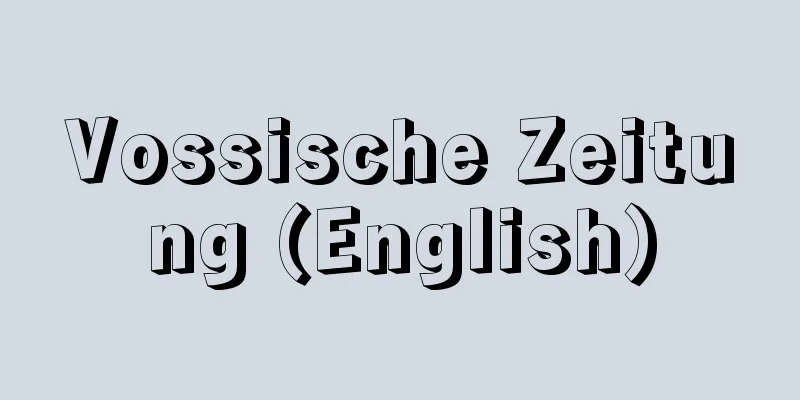Soft tennis - Sofutotenisu (English spelling) soft tennis

|
Soft tennis is a ball game that originated in Japan from lawn tennis. The playing method is similar to tennis, but soft rubber balls are used. Soft tennis has a history of over 120 years since 1884 (Meiji 17), and is a popular sport with over 540,000 players and an estimated 7 million fans. Meanwhile, efforts to popularize the sport internationally have been successful, and organizations such as the International Soft Tennis Federation and the Asian Soft Tennis Federation have been formed, with many countries and regions around the world joining these organizations, totaling 40 countries. It was adopted as an exhibition event at the Beijing Asian Games in 1990 (Heisei 2), and was adopted as an official event at the Hiroshima Asian Games in October 1994. In line with this age of internationalization, the name "soft tennis" was changed from "soft tennis" or "soft tennis", which had been familiar to many people for a long time, to "soft tennis" in 1992. Lawn tennis, which was introduced from overseas in the early Meiji period, was difficult to obtain because the balls were imported, and it was technically impossible to manufacture them domestically, and they were also expensive, which was an economic problem. When they tried using soft rubber balls, which were relatively easy to obtain as a substitute, as they were used for girls' ball games, it turned out to be good enough, so tennis began to be played with rubber balls, and this was the origin of soft tennis. It is said that the original balls were made in Germany and had the Blue Horse mark. It was first played at the Gymnastics Training School, which later became the Tokyo Higher Normal School, and since then rubber ball tennis, which remained the name "lawn tennis," gradually became more popular. Around 1897, rubber ball tennis came to be called "tenikyu" in Japanese. It is said that this term was born from the fact that tennis courts were called "kyutei" (ball courts), and the idea that the reverse of that would be more appropriate for tennis. Tokyo Higher Normal School was located in Ochanomizu, and students at the nearby Tokyo Higher Commercial School in Kanda Hitotsubashi also loved the sport, and in 1898 a match between the two schools was held. This led to the sport being played at public and private technical schools in Tokyo. Meanwhile, graduates of the Higher Normal School were posted to other parts of the country, so soft tennis quickly spread to junior high schools in each prefecture. It was hugely popular during the Meiji period, and was said to be one of the three major sports (after baseball, tennis, and boat racing). In 1903 (Meiji 36), Waseda and Keio joined the two schools, and a four-school league match was held, at which point the first rules for the sport in Japan were created. "Matches will be played as doubles, with teams made up of seven pairs. The winner is the first to win three out of five games. The winners of the first two pairs to beat the opposing team will first retire, and the third pair will play against each other. The retired pairs will then play against each other, and when the opposing team has no retired pairs left, the match is won. Various revisions were made to the umpire's judging methods as the matches were played, such as the position when serving, how the serving pair is decided, and how to handle balls outside the dividing lines (outs)." The rules adopted for the 1908 tournament have been the rules of soft tennis competitions for a long time thereafter. In the Taisho period, some universities switched to hardball tennis and the sport began to decline, but at the same time, women's sports began to emerge in Japan, so it remained as the main women's sport. In the early Showa period, a dispute arose over the rules when participating in the Meiji-Jingu Games, and the federation was divided into the Japan Softball Association and the All-Japan Soft Tennis Federation, and the sport was also called "tennis," "softball," or "soft tennis." However, when Japan joined the Dai-Nippon Taiiku Kyokai (later the Japan Amateur Sports Association, now the Japan Sports Association) in 1939 (Showa 14), the official name "soft tennis" was approved to avoid confusion with hard tennis. At that time, the war was gradually becoming more intense, and it was a time when rubber for making balls could not be distributed unless you were a member of the Taiiku Kyokai. Gradually, it became impossible to hold national tournaments, and soft tennis, like other sports, stagnated as players were sent off to war. After the Second World War, soft tennis competitions were spurred on by the introduction of an instructor system and have developed again. In recent years, with the aim of making soft tennis more appealing, promotional measures have been implemented with basic policies such as "improving the rationality of the competition," "improving competitive ability," and "improving internationality." Through such measures as holding national tournaments for all age groups from elementary school students to the elderly, expanding international tournaments, revising the competition rules to emphasize equality among players, and implementing a consistent national-level player development program, soft tennis has become established as the most popular sport in Japan and is enjoyed by many people regardless of age or gender. [Japan Soft Tennis Association] [Reference] |Source: Shogakukan Encyclopedia Nipponica About Encyclopedia Nipponica Information | Legend |
|
ローンテニスを母体として日本で生まれた球技で、競技方法はテニスと似ているが、軟らかいゴムボール(軟球)を使用する。ソフトテニスは1884年(明治17)以来 120年余りの歴史をもち、54万人を超える競技人口と、700万人と推定される愛好者をもつ大衆的競技スポーツである。一方、国際普及への努力が奏功し、国際ソフトテニス連盟、アジアソフトテニス連盟などの組織が結成され、世界の多くの国々(地域)がこれらに加盟し、その数も40か国に及んでいる。1990年(平成 2)の北京(ペキン)アジア競技大会で公開競技に採択され、1994年10月の広島アジア競技大会には正式種目として採用された。このように競技の国際化時代にあわせて、長い間多くの人たちに親しまれてきた「軟式庭球」または「軟式テニス」という名称から、1992年「ソフトテニス」という名称になった。 明治初期に外国から伝来したローンテニスはボールが輸入品なので入手しにくく、国内で製造するのは技術的にとても無理であったし、また高価なので経済的にも問題があった。その代用品として比較的入手しやすかった、女の子の手まり用の軟らかいゴムボールを使用してみたら、十分にまにあうというので、ゴムボールを使用してテニスが行われ始め、これがソフトテニスの発祥となった。当初のボールはドイツ製で青馬印のマークがついていたといわれている。最初に行われた場所は体操伝習所、後の東京高等師範学校で、それ以来「ローンテニス」という呼称のままでゴムボールのテニスはしだいに普及していった。明治30年ころには、このゴムボールのテニスのことを日本語で「庭球」と呼称するようになった。テニスコートのことを「毬庭(きゅうてい)」といったことにちなんで、それを逆にしたらテニスにぴったりではないかということでこの用語が生まれたといわれる。東京高等師範学校はお茶の水にあり、その近くの神田一ツ橋にあった東京高等商業学校の学生たちもこのスポーツを愛好し、ついに1898年両校の対抗試合が行われた。これがきっかけとなり、東京の官・私立専門学校で行われるスポーツになった。一方、高等師範学校の卒業生は地方へ赴任していったので各府県の中学校にもソフトテニスは急速に普及した。明治時代大いに流行し、三大スポーツ(野球、庭球、ボートレース)の一つといわれた。1903年(明治36)、この両校に早稲田(わせだ)、慶応が加わり4校のリーグ戦の対抗試合が行われ、この際に日本で最初の競技規則がつくられた。「試合はダブルスとしチームは7組で編成する。5ゲーム中3ゲーム先取したら勝ちとなり、相手の2組に勝った勝者はまず優退し、第3組目は新しい組同士が対戦する。さらに優退組同士も対戦し、相手に優退組がなくなったとき、試合に勝ったことになる。サービスをするときの位置、サービスする組の決定の仕方、区画線外のボール(アウト)の処理」など試合を重ねていくうちに審判の判定方法などについていろいろな改正が行われて、1908年の大会で採用されたルールが、その後長い間ソフトテニス競技の規則になっている。 大正期に入り、一部の大学が硬球に転向して衰退しかけた時期もあったが、時を一にして日本に女子のスポーツが台頭してきたので女子のスポーツの中心種目として存在した。昭和初期、明治神宮大会へ参加の際にルールについて対立が生じ、連盟が「日本軟球協会」「全日本軟式庭球連盟」とに二分され、この競技も「庭球」「軟球」「軟式テニス」などとよばれたりしたが、大日本体育協会(のちの日本体育協会。現、日本スポーツ協会)に加盟した1939年(昭和14)を機に、硬式との混同を避けるために「軟式庭球」という正式名称で承認された。当時はだんだんと戦争が激しくなってきていたので、体協に加盟していないとボールをつくるゴムの配給が受けられないという時代であった。しだいに全国的な大会も開くことができなくなり、プレーヤーの出征などで他のスポーツと同様に軟式庭球も停滞していった。 第二次世界大戦後のソフトテニス競技は指導員制度の導入などに拍車がかけられ、ふたたび発展していった。さらに近年、魅力あるソフトテニスづくりを目指して、「競技の合理性の向上」「競技力の向上」「国際性の向上」などを基本方針とする普及振興策が図られ、小学生から高齢者まですべての年齢層に対する全国大会の実施、国際大会の拡充、プレーヤーの平等性を重視した競技規則の改定、一貫性のある全国レベルの選手育成プログラムの実施などにより日本における最も大衆的なスポーツとして定着し、老若男女を問わず多くの人々に愛好されている。 [(財)日本ソフトテニス連盟] [参照項目] |出典 小学館 日本大百科全書(ニッポニカ)日本大百科全書(ニッポニカ)について 情報 | 凡例 |
<<: Soft drink - Sofutodorink (English spelling) soft drink
Recommend
Neidhart von Reuenthal
Minnesenger was a German poet from Bavaria. His bi...
Alexandrovsky, VD - Aleksandrovsky
...In terms of practice, the goal of "integr...
Noh book - Utaibon
A Noh script with musical scores for Noh rehearsa...
Housekeeping - Sculpin
...The educational goal through these was to teac...
Muneyoshi Yanagi
Art critic and religious philosopher. Known as an...
Bharal - Bharal (English spelling)
A mammal of the bovidae family in the order Artiod...
Owings, N. - Owings
...known for designing large commercial buildings...
Tenmon
One of the volumes in the ancient Chinese literary...
Star Dune
... As the sand moves, the grains become rounded ...
Kaplan, K.
…Usually, the runner blades are opened and closed...
Isograd
Introduced by Tilley, metamorphic grades are diffe...
American crayfish (English name: Procambarus clarkii; red swamp crayfish)
A freshwater shrimp native to the Louisiana area o...
mafioso
… [Sicily] Refers to organized crime unique to Si...
Isogai Jirozaemon
...It is said that the person who introduced Chin...
Schumacher, E.
...But Hitler's crackdown on "degenerate...









